
In 1956, Weatherby gave dangerous game hunters the ultimate .375 caliber, the jumbo 378 Weatherby Magnum. In 1957, Weatherby released its newly designed Mark V action; big enough and strong enough to handle the 378 Weatherby Magnum’s then current and future potential. In 1958, to comply with the East African Professional Hunter’s Association ban on the use of sub 40 caliber rifles on thick skinned and dangerous game, Weatherby introduced the 460 Weatherby Magnum 1).
The current 460 Weatherby Mark V Deluxe is not so different from the original. The big Mark V 9 lug action remains front and center. The blued steel barreled action is finished to a high lustre and almost black in color. The bolt and magazine follower are neatly jeweled. The walnut stock is straighter grained then with lesser recoiling Weatherbys, but with good color and contrast. The forend and grip are capped with rosewood, set apart from the walnut with maple and rosewood spacers. A diamond shaped maple blaze is inlaid into the rifle’s pistol grip.
There are areas that differ from the original Mark V; high lustre anodized aluminum bottom metal in place of steel, precisely laser cut checkering in place of hand cut checkering, a factory tuned trigger, and a button rifled barrel for greater accuracy rather than hammer forged for production expediency.
The modern Weatherby Mark V Deluxe is designed for hunting with magnum cartridges with shooter comfort and safety as primary considerations. The Mark V design truly is an instance of form following function.
The 54º bolt lift yields a short throw and permits low scope mounting. The bolt body is fluted to reduce drag and vented in three places to safely dump off gases in the event of a pierced primer. The bolt head and body are the same large diameter for maximum strength, nine locking lugs instead of two or three increase engagement surface contact and a cartridge’s case head is enclosed in three rings of steel; bolt, barrel and receiver.
|
Weatherby Mark V |
|
| Manufactured | California, USA |
| Model | Deluxe |
| Caliber | 460 Weatherby Magnum |
| Capacity | 2+1 |
| Stock | AA Walnut – Rosewood Caps |
| Hardware | High Lustre Blue Steel |
| Barrel Length | 28″* |
| Twist Rate | 1:16“ |
| Weight | 10 Lbs |
| Overall Length | 48 3/4″ |
| Pull | 14.0″ |
| Drop at comb | 7/8″ |
| Drop at Monte Carlo | 3/8“ |
| Drop at heel | 1 3/8“ |
| Sights | Clean Barrel D&T |
| Trigger Type | Factory Tuned |
| Trigger Pull – Received | 3 lbs. 7 oz. |
| MSRP | $3,300 |
|
* 26″ barrel + 2″ brake |
|
I’ve had people ask if I thought Weatherby might update their “style”, lose the Monte Carlo comb and squared forearm. That is like asking when a company will remove the teeth from a saw or the head from a hammer.
The distinctive Weatherby stock does more than look good. The upward tapered forearm provides better grip and control under heavy recoil. The stock’s cast off comb provides proper support for eye – scope eyepiece alignment, however, it moves away from the shooter’s face under recoil to avoid face thumping. The swept pistol grip keeps fingers away from the back of the trigger guard and the Decelerator recoil pad absorbs recoil while providing good lateral stability. For me, the 460 Weatherby Magnum and Weatherby Mark V rifle are the epitome of power and grace, the quintessential Weatherby.
A few illustrations of the prior narrative…
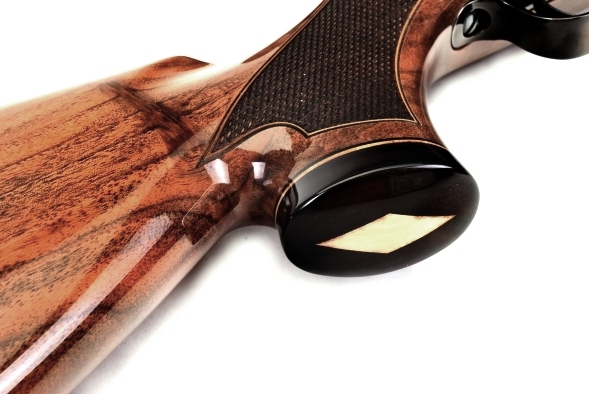
At a time when even most expensive rifles poly cap everything, the use of mixed exotic and hardwood, nicely shaped and finished is a welcome touch and sets the Weatherby Mark V Deluxe apart from other premium grade rifles.
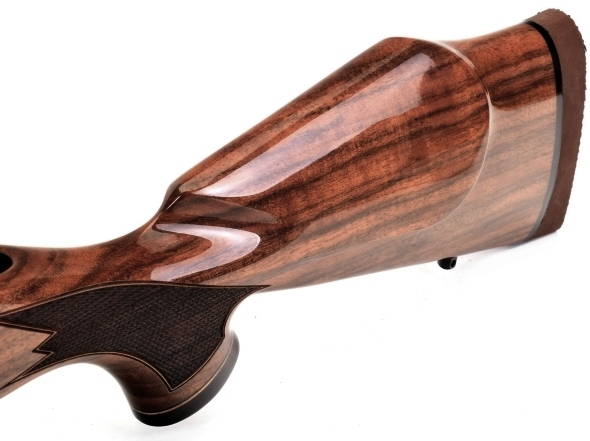
The slender grip makes for a good hold and its geometry makes for strength. The cheek piece is comfortable against a shooter’s face, moved away from the shooter’s face under recoil.
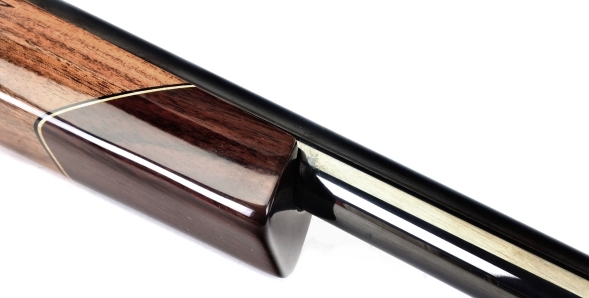
Of all of the different forend tips, this one is probably the most recognizable. It gives the rifle a nice profile and tends to lighten its appearance. My next best favorite is the schnabel, but owning that type of rifle requires the wearing of woodland lederhosen and an Alpine hat.
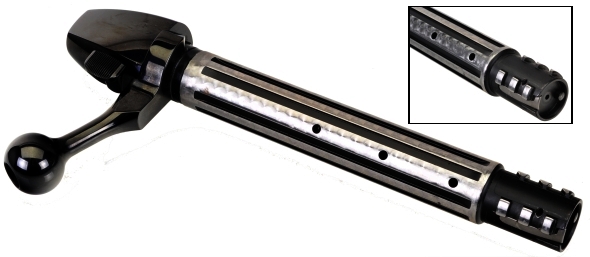
Six of the nine lugs are visible, as well as the recessed bolt face, flutes, gas bleed ports and jewelling… sort of. The engaged, the two position safety locks the striker, locks the bolt and disengages the sear.
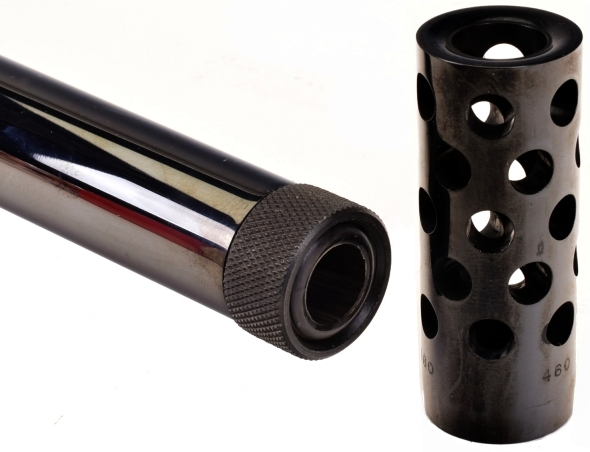
Not covered in the opening narrative, but a good lead in to the next section, Weatherby’s Accubrake™… and it is a good one, cutting felt recoil by as much as 53%. Recoil for the 460 Weatherby Magnum is cut to 375 Weatherby Magnum levels, or approximately 47 ft/lbs. For folks who would rather not use a brake, it easily unscrews and is replaced with a thread protector. The brake is standard on all Weatherby Mark Vs above 30-378 Weatherby Magnum power and optional on others.
inexperienced shooters give good rifles bad reputations – Nietzsche
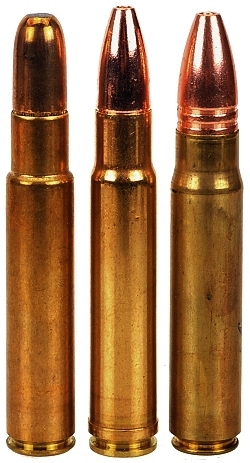 Over the years, I’ve had the good fortune to work with a considerable number of big bore, high power firearms… enough to cause me to occasionally forget my name and address. However, with more than a little experience with the Weatherby Mark V rifles, I’ve found them to be some of the easiest shooting magnum rifles. So why do grown men burst into tears with takes of Weatherbys that kicked them into the next zip code?
Over the years, I’ve had the good fortune to work with a considerable number of big bore, high power firearms… enough to cause me to occasionally forget my name and address. However, with more than a little experience with the Weatherby Mark V rifles, I’ve found them to be some of the easiest shooting magnum rifles. So why do grown men burst into tears with takes of Weatherbys that kicked them into the next zip code?
A person experience shooting 300 or 338 Winchester Magnums will appreciate the corresponding Weatherby Mark V’s ability to manage and softens recoil. Conversely, it will be difficult to slip the recoil of a 300 or 340 Weatherby Magnum, unnoticed, past a person whose shooting experience is predominately based on shooting a sporter weight 308 Winchester.
It follows that the recoil of the 460 Weatherby Magnum isn’t exceptional within the context of firearms of similar capability and within a population of shooters with this type of shooting and hunting experience. However, even where there is experience, these are not the types of firearms uncased for a day of varmint shooting. They are generally shot only enough to maintain proficiency and then when hunting something that represents a great enough risk to life to warrant this kind of horse power.
Pictured from left to right: 450 Rigby, 460 Weatherby and 500 Jeffery. For folks who insist on quantitative expression, rather than my emotional reactivity analogies; the 460 Weatherby recoil generates approximately 110 ft/lbs of recoil, which is not the same as felt recoil and does not take into consideration secondary jet or muzzle pressure induced recoil. The 450 Rigby generates approximately the same and factory 500 Jeffery ammo bumps that up to 130 ft/lbs… 150 ft/lbs for our handloads. By comparison, a rifle of similar weight chambered for the 375 H&H generates approximately 45 ft/lbs of kinetic energy, about the same as my Model 1895 Guide Gun when loaded with modern +P+…++ 400 grain 45-70 handloads.
Who needs this powerful of a rifle? Didn’t some guy kill elephants with a 22 magnum?
In factory form, the current 460 Weatherby Magnum is actually slightly detuned from the original with a 500 grain bullet @2,600 fps, generating 7,504 ft/lbs of kinetic energy. In 1961 – 1962 “Tomorrow’s Rifles Today, the top 500 grain load is listed as 2,725 fps and 8,245 ft/lbs. Some folks might claim both are over the top for even the largest game and proceed to evoke the name “Karamojo” Bell, citing his history of downing elephants with small bore rifles such as the .275 Rigby, 6.5x54mm, 303 British, and .318 Westley Richards.
Today, elephants aren’t culled in mass by professional ivory hunters, shooting from a distance. Shots are taken comparatively up close, 15 – 40 yards on the average. Shots to the brain are not primary, the broadside heart shot is preferred; behind the front leg and halfway up to chest to strike a heart the size of a 5 gallon pail and it takes a big hole to empty a 5 gallon pail. Penetration, a large wound channel, the ability to break bones to stop forward motion all become important cartridge capabilities for this type of hunting and the 460 Weatherby Magnum delivers has this ability.
No, I am not trying to pass myself off as a specialist in hunting elephant and similar dangerous game, I am only explaining the rationale stated in credible text written by folks who are knowledgeable. What I can do is collect interior, exterior and terminal ballistics data and examine the function and aesthetics of the machinery and present that information. Subsequently, the next step is for us to shoot some factory ammo, select some components and assemble some handloads and collect some data on the results.
Choices, choices, choices…
At last check, there were over 100 0.458″ bullet types and brands. The 12 appearing below reflect what was left of my 45 caliber rifle bullet inventory after extracting 30 types of flat nose 45-70 Gov’t bullets… although some of the others are not for use beyond a 458 Winchester class cartridge. I do believe the weight range is correct for what we have in mind.

The intention is to light load at 350 grains and spec load up through the 550 grains, keeping in mind the impact velocity intended by design for each. At the moment I am more concerned with the exterior ballistics of each bullet type and accuracy than I am with finding a load suitable for elephants. Let them work up their own handloads. Part 2 coming soon.
1) “Any Shot You Want” – A-Square, Arthur B Alphin Editor
Weatherby’s Mark V 460 Weatherby Magnum Part 1
Weatherby’s Mark V 460 Weatherby Magnum Part 2

Email Notification